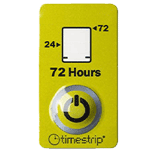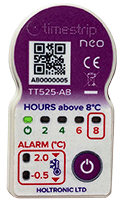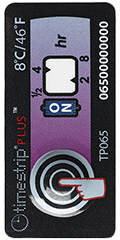Timestrip PLUS











Used by world leading brands
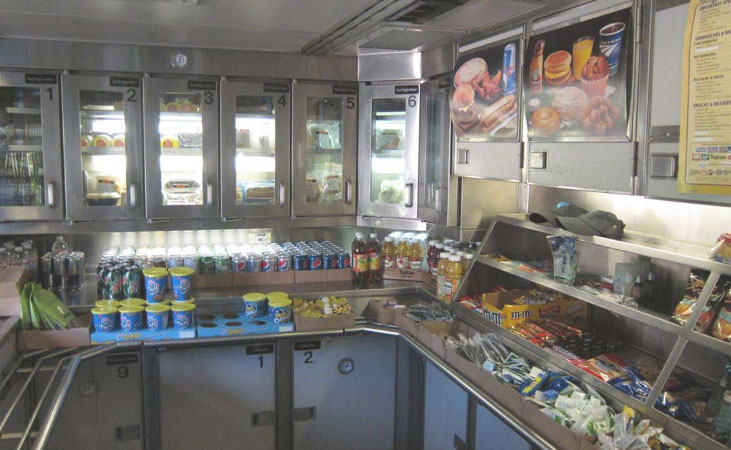
For blister on top products: Firmly squeeze the blister on top of the indicator. For blister on bottom products: Firmly squeeze the blister on the bottom of the indicator.
Once activated, an activation line appears in the first window – the activation window- and continues to fill the window until it reads “ON”.
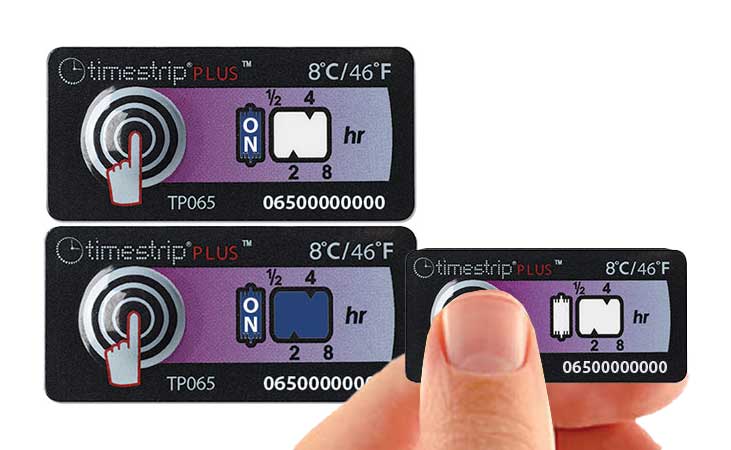
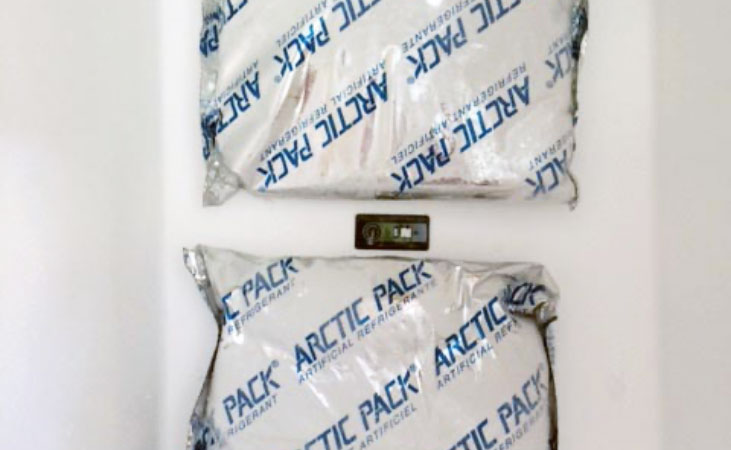
Timestrip time temperature indicators have a window that starts to fill with a coloured dye when the temperature of the shipment goes above the threshold and stops when temperatures drop back down.
When another elevated temperature occurs, the colour dye will resume progressing, marking time laterally by filling the window and passing the convenient time markers.
At the end of a shipment, the Timestrip TTI breach monitoring window will show the total cumulative time of all the elevated temperature breaches.
Timestrip Plus
Yes, this is one of our strongest points of differentiation vs. other products. Timestrip® Indicators can be loaded bulk, orientated and ready to be custom applied and even activated inline if the application warrants it.
Timestrips® are not designed to be submerged in water, but they are very splash-proof and can be immersed in water for short periods without any effect.
If the indicator is correctly activated false positives are extremely unlikely as the blue dye can only melt at or above certain temperatures. It is important to lower the indicator to its STOP temperature after activation and only attach it to a product, carrying card or material that is already at or below the STOP temperature to avoid premature indication.
They are suitable for many situations when elevated temperatures can create problems for a product. Common applications are frozen or chilled foods, medicines, vaccines, adhesives and chemicals. A common use is to identify the elapsed time of temperature abuse during shipping. Another is for products which are taken repeatedly in and out of their ideal storage conditions for temporary use, like lab chemicals. One or two excursions might not be problematic, but Timestrip® PLUS shows the cumulative time of all excursions and this can be used to trigger a timely replacement of the product.
It is a single use temperature indicator in a self-adhesive format. It indicates if temperature has risen to breach a defined threshold and it records the cumulative elapsed time of all such breaches. Each product in the range is engineered to respond to a different threshold temperature so customers can choose the product that best suits their needs.
There are fundamental differences. Data loggers are expensive and typically are designed to go on large shipments. They are not an immediate tool as they need to be returned/connected for the data to be read and acted on, and they have to be used repeatedly to justify the expense. They also require power. Timestrip® PLUS indicators are less expensive, require no power, are single use and can be instantly read by the end user. They have unique serial numbers to ensure the traceability of each indicator to avoid the potential for manipulation across the distribution chain. As well as being effective for large shipments, Timestrip® PLUS are small light and cost effective enough to be used at the carton or single unit level. Using them at multiple points within a shipment or container can isolate unacceptable temperature pockets. Data loggers provide a full history of temperature from the time of activation. Timestrip® PLUS records how long a product has been above its threshold temperature (up to the maximum printed on the scale - usually 8 or 12 cumulative hours) but cannot tell you when the breach or breaches occurred. Timestrip® PLUS is most often used to monitor and validate the ‚ 'last-mile' of a cold chain or other temperature environment, in other words, when the product is close to its eventual use. In some cases data loggers and Timestrip® PLUS indicators may be used in complementary ways to help monitor temperatures.
A blue dye housed in a blister is held adjacent to a micro-porous membrane. Upon squeezing the activation button the liquid dye comes out of the blister and into contact with the membrane. If the temperature of the product is below the stated ‚ STOP temperature, the blue dye changes state to solid form, and it is unable to move through the membrane. If the temperature rises to or above the threshold temperature, the dye changes to liquid form and moves at a precise rate through the membrane. Its progress is irreversible and the distance it travels through the viewing window indicates the cumulative time the indicator has been exposed to the threshold temperature or above. Once activated, Timestrip® PLUS will keep monitoring temperature for days, weeks or months, depending on your needs. During that time it will record how long any temperature breaches last. Here is an example. An 8ºC Timestrip® PLUS was chosen to monitor a shipment which would take 3 weeks to arrive. When the shipment arrived, the indicator showed 4 hours of 8ºC breach. This breach could have happened in one long event or from a series of shorter breach events across the 3 weeks. The 8ºC Timestrip® PLUS could have indicated up to 8 hours of temperature breaches during that 3 weeks.
The melting point of a solid is the temperature at which it changes state from solid to liquid. The freezing point (or crystallization point) is the temperature at which a liquid changes to a solid. For certain substances the melting and freezing point are not the same and the freezing point is lower than the melt point. This behaviour is called hysteresis. At the STOP point (freezing point) the dye can't move. At the melt point the dye moves and indicates a threshold breach.
No. Unlike some other threshold temperature products, Timestrip® PLUS does not require pre-conditioning. You need to activate above the product's threshold temperature, as you cannot squeeze the dye out of the blister if it is in solid form. Immediately after activation, stop the progress of the dye by placing the indicator below its STOP temperature. You can adhere the Timestrip immediately to a product or carrying card which is below the STOP temperature. Alternatively place the activated indicator in an environment much colder than the STOP temperature for a short period of time.
No, unlike some other threshold temperature products, Timestrip® PLUS can be stored inert at ambient temperatures and only activated when needed.
Most Timestrip® PLUS products are provided with a shelf life of 2 years from shipping from our premises. Some formulations may be provided with a shelf-life of 2 years from date of manufacture. In all cases, an expiry date is provided for each batch of products supplied.
If stored under the correct conditions, there is very little risk of auto-activation, but occasionally, this can happen, and the built-in activation window lets you know it. If an indicator has auto-activated before use the activation window will already be showing blue and ON. The blue liquid may also be showing against the time-markers in the run-out window. If this happens, discard the indicator and select another. There is no need to contact us, as we ship a few extra units per hundred anyway.
We have a wide range, but if none of our products suit your needs we can investigate a new threshold temperature. There is a cost for this development service and not all temperatures are possible. Please contact us for more information.
For a minimum order value of 50,000 units we can make a customised Timestrip® PLUS. There is a set up and per unit premium for this service dependent on the specifications required. Graphic customisation can include changing the scale on the run-out window to different time markers and using customer logos and colours. It can also include hiding the progress of the blue dye so the end user just sees when a maximum elapsed time of temperature abuse has been reached.
Timestrip® PLUS can only show ascending temperature excursions. We have other products that do this type of descending temperature indication.
+/- 1ºC for the temperature component and 15% for the time component under isothermal conditions. The progress of the blue dye across the time-markers is calibrated to a temperature of 2ºC above the stated threshold temperature. For example, the time markers for Timestrip® PLUS 12ºC are calibrated to a temperature of 14ºC. When the product breaches its threshold temperature and is held at a constant temperature of 14ºC (i.e. isotherm), the blue liquid will reach the 1 hour print mark within 1 hour (+/- 15% in time). If the breach is at a much higher temperature than the stated threshold temperature, the indicator dye becomes thinner and will run faster.
Anything where elevated temperatures are an issue.nCommon applications are frozen or chilled foods, medicines, vaccines, blood products and adhesives.
We have a growing range of standard products that meet most cold chain requirements. As a general rule, if you require more than 50,000 units, we can customize the print, and in many cases, even the melt temperature, although we have an extensive existing range. There is a premium for this service. We can also quote on custom carrier cards and backing labels,nif you need to provide instructions, add other languages, or a form to provide a permanent record.
Timestrip® PLUS are polymeric multi-layer indicators. They are based on spontaneous lateral wetting by a blue liquid inside a porous substrate and not a chemical reaction. Each production batch (7000 - 8000 products) undergoes strict quality control tests to validate its time accuracy. This is conducted via a computer vision software (TSCV) which analyses scanned photos of seven randomly-selected products from each batch (roughly 0.1% of the population). The photos are taken at different elapsed times and the tested products are placed at their designated temperature through the entire test period. The software automatically analyses the lateral progress and the elapsed time of each product tested and the data is presented numerically and graphically in a specific file which is labelled by batch. This data is translated into a final release report which is attached to the outgoing product batches.
Every Timestrip® PLUS product is calibrated to a temperature of 2ºC above its stated threshold temperature. For example, Timestrip® PLUS 12ºC is calibrated to a temperature of 14ºC. When the product breaches its threshold temperature and is held at a constant temperature(i.e. isotherm) of 14ºC, it will reach the 1 Hour print mark within 1 Hr (+/- 15% in time).
The maximum run-time varies between hours to days dependent on the product and its application. Note that the run-time is only referring to the time above its breach temperature. Timestrip® PLUS can remain active and vigilant for long periods of time (up to a year after activated) if the run out window has not completely filled in.
Products are supplied loose in poly bags as standard. Subject to a premium and technical parameters, they can also be provided on rolls for integration into packaging lines or in boxes.
The activation window gives confidence that the product is armed. The breach/run-out window is separate so that it clearly indicates a breach of the temperature threshold and the cumulative elapsed time of the breach.
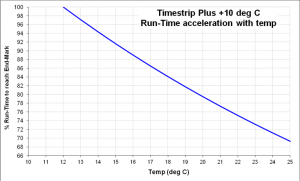
Due to the nature of liquids, higher temperatures reduce the viscosity of the liquid dye in Timestrip® PLUS. The correlated result is faster/shorter run-times (the progressing blue dye will reach each printed time-mark sooner than intended). So, if an 8ºC/46ºF indicator is exposed to 25ºC/77ºF for a consistent period then the blue dye will progress more quickly through the membrane than if it was exposed to 10ºC/50ºF for a consistent period. This graph shows the run-time acceleration of a 10ºC/50ºF Timestrip® PLUS at different elevated temperatures.nnThe y-axis represents the actual run-time of the liquid dye at different temperatures, and is expressed as a percentage of the specified run-out time at an isotherm of 12ºC/54ºF. So, at an isothermal temperature of 12ºC, the liquid dye will reach each time-marker (1, 2, 4, 8, hours etc) within these times +/-15% in time. However, if for example the product is exposed to an isotherm of 21ºC/70ºF the dye will reach each time marker within only 77% of the intended run-time. In other words, it will reach the;n
- 1 hour time-marker within approximately 46 minutes (77% of 1 hour)
- 2 hour time-marker within approximately 1.32 hours and so on.
At a less extreme temperature elevation, say 15ºC/59ºF the blue dye will reach each time-marker at 91% of the intended time.
Timestrip also offers a ‘tti thermometer’ in the form of the Timestrip VST TTI that is designed to integrate time and temperature.
The Accepted Failure Rate is based on ANSI/ASQC Z1.4 (formally MIL-STD-105E) Level II Normal Inspection. Packs are over shipped by 2-3 units per 100 to cover this AQL.nnCentral to this process are tests against defined specifications for; how quickly the dye progresses through the membrane, environment sensitivity (high heat and vacuum tests to check resilience to harsh conditions during shipping) and also the accuracy of the threshold melting point. A full pack of release reports is provided with each shipment. Further details are available on request.
Yes. Orientation has no impact on the way it works.
Yes. Please contact us for the MSDS for further information. We only use food-grade oils and non-toxic colourants in our formulation. In the unlikely event that the liquid leaks from the indicator and comes into contact with skin, simply wash with soap and water. If the liquid comes into contact with eyes, rinse immediately with plenty of water and seek medical advice.
Because we like our customers! You can use these free products for testing, training, validation, or just to save money. In the unlikely case any got damaged along the way or someone just wanted to try one, there is no need to get in touch, although we're always happy to hear from our customers. Personally, we think that all companies should give stuff away for free!

